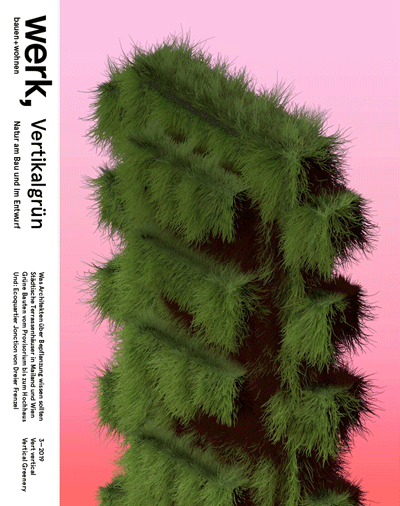werk, bauen + wohnen 3–2019

Weather Garments
Daily life in the old town and in a middle-class residential district; young green plants cover old walls like a protective coat: ivy, wisteria, Virginia creeper – depending on the time of year in flower, fragrant or buzzing with insect life. And it is not just the bees that find a rich harvest on the house wall but also people. Grapes, pears, apricots – fruit of all kinds grows on trellises.
Reform housing from the early 20th century up to the time of Heinrich Tessenow is permeated by this idea, the trellis is a symbol of self-sufficiency and a natural idyll. Are we perhaps cultivating similar ideas today in the form of “urban farming” and “vertical gardens”? The seductively luxuriant greenery allows us to recognize a need to experience nature at close hand in our everyday lives. One could see the trend towards greenery as a reaction to the alienation experienced under modernism. But the hype about trees on tower blocks and gardens in the vertical also meets with deep-rooted mistrust. “What, now we are supposed to design green buildings?” For some this is reason enough to turn away in disgust. Further voices from the choir of objectors: building physics, barrier-freedom and BIM. Let’s call this architecture’s current B-side.
But for a building vertical greenery offers a lot of positive concrete functions: evaporation cooling, sun protection and improved air quality. Of course, the reservations go far deeper, as “stability” is one of the foundations of architecture. But greenery flourishes and withers. It needs to be cared for and kept in check, otherwise it becomes rampant and overgrows the architectural design. Recognizing the dynamic aspect of greenery, its changeability, as part of architecture runs contrary to the beliefs of many.
It is time to recall again the forgotten qualities. On this account we want to take a critical look at vertical greenery in this issue, but without losing sight of its architectural, economic and biological requirements. The seductive visual power illustrated by the most recent examples generally comes from more tropical zones, for instance Singapore or Vietnam, where climatic conditions are very different. This issue on facade design offers a good basis for training for climate change. For those who want to know more than the condensed information offered here: this issue also serves as a catalogue for the exhibition Gebäude.grün, which can be seen from 21 March – 15 May 2019 in the Architekturforum Zürich. — Roland Züger